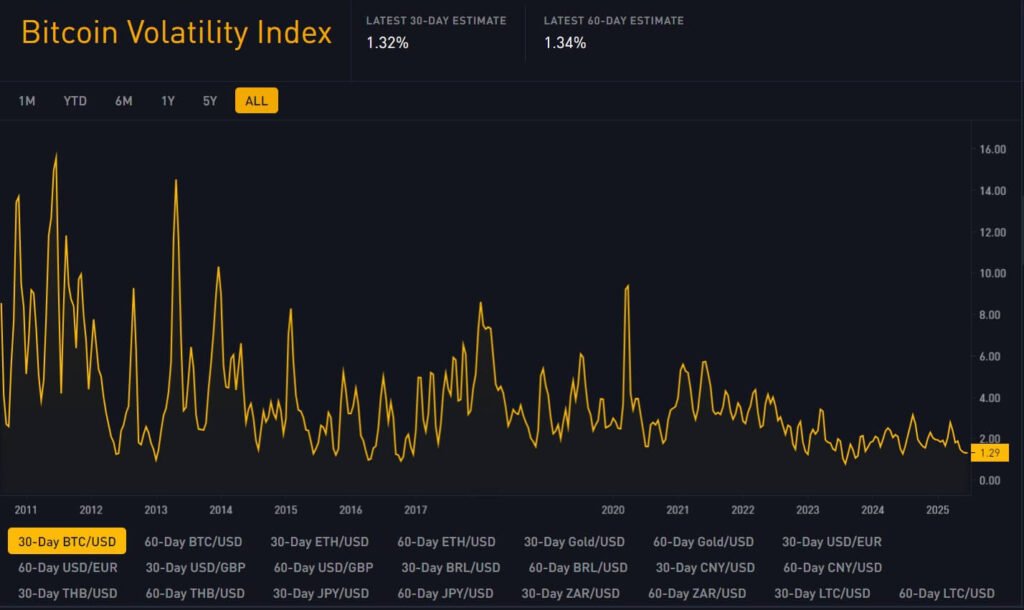For years, Bitcoin has faced intense scrutiny from traditional investors, policymakers, and financial advisors. And, this scrutiny was largely due to one recurring concern: Bitcoin’s volatility. Often portrayed as a speculative asset, Bitcoin has been deemed too risky for serious portfolio inclusion. But is that reputation still deserved?
Recent data suggests otherwise. According to a June 2025 report by Fidelity Digital Assets, Bitcoin’s 90-day realized volatility has fallen below that of 33 S&P 500 companies—including tech giants like Tesla and Netflix. In fact, its volatility has dropped more than 75% from peak 2022 levels, signaling a dramatic shift in market behavior.
This matters because Bitcoin’s volatility has long been the final hurdle for institutional adoption and mainstream investor confidence. As the asset stabilizes, it opens new doors for wealth managers, hedge funds, and even sovereign reserves to consider meaningful exposure.
In this article, we’ll explore why Bitcoin’s volatility is shrinking, what the data reveals about its evolving market profile, and how this trend is reshaping investment strategies for both institutions and long-term retail investors. If you’ve written off Bitcoin as “too volatile to touch,” it might be time to think again.
Is Bitcoin Really Volatile?
Bitcoin’s wild price swings have long kept traditional investors wary. But as volatility shrinks rapidly, that could change. Lower volatility not only enhances portfolio integration—it signals maturation, as asset managers increasingly treat Bitcoin like other mainstream financial instruments.
Philippe Laffont of Coatue Management recently highlighted this shift. He noted that Bitcoin’s volatility has eased enough to compare favorably with Nasdaq 100 stocks, marking a crucial inflection point for institutional interest.
Bitcoin Is No Longer Volatile—And We Have the Data to Prove It
Bitcoin’s 30-day volatility has dropped to just 1.29%, the lowest point in over a decade (see the graph below). For context, this is now on par with or even lower than many S&P 500 tech stocks and commodities like gold.

Here’s what the data shows:
- In 2011–2014, Bitcoin’s volatility regularly exceeded 10%, peaking above 15% during market turmoil.
- During the 2021 bull run, volatility spiked again near 8% as price surged past $60,000.
- Since 2022, there has been a sustained downward trend. Now in 2025, volatility has compressed by over 75% from historic highs.
Let’s compare Bitcoin with traditional stocks. According to Fidelity Digital Assets report, Bitcoin is now less volatile than 33 S&P 500 stocks, compared with late‑2023 when 92 S&P companies exceeded its volatility. Their research also reveals Bitcoin’s 90‑day realized volatility hovered around 46%, compared to Netflix’s 53%.
Similarly, BlackRock’s iShares analysis shows Bitcoin’s annual volatility is now roughly 4.6× global equities and 3.9× gold—but trending downward as markets mature.
Institutional Metrics
By mid‑2025, realized volatility dropped an estimated 75% from historical peaks. Contributing factors include deeper liquidity and “strong‑hands” institutional investors less prone to panic selling.
Glassnode and Gemini’s H1 2025 joint report points to growing sovereign custody, corporate reserves, and off‑chain trading infrastructure—all driving more stability.
Forecasting Perspectives
Academic research confirms that incorporating on‑chain metrics and machine learning models can forecast volatility with greater accuracy than traditional techniques—signaling Bitcoin’s market behavior is becoming more predictable.
Institutional Adoption Accelerates
Billionaire and Hedge Fund Involvement
Philippe Laffont added Bitcoin to Coatue’s “Fantastic 40” and attributes a nearly 13% YTD gain in 2025 to falling volatility, which he says improves Bitcoin’s risk profile.
Family Offices and Wealth Managers
A BNY Mellon‑sponsored Financial News report reveals 39% of single‑family offices are exploring crypto. CoinShares adds these portfolios now average ~1.8% crypto, rising year‑over‑year. Advisors often recommend modest allocations (2–5%) for risk‑adjusted upside.
University Endowments and Foundations
U.S. university endowments, including Yale, UT‑A&M, and newer outfits like University of Austin’s $5 million Bitcoin fund, have embraced digital assets. These institutions recognize that missing crypto exposure may constitute an opportunity cost.
State-Level and Federal Reserves
Bitcoin ETFs cleared the way for public pension involvement. States like Arizona, Michigan, and Wisconsin have taken initial steps toward Bitcoin ETF allocation.
At the federal level, an executive order signed in March 2025 authorized a U.S. Strategic Bitcoin Reserve, funded via seized BTC. The Treasury reportedly holds ~200,000 BTC—cementing Bitcoin’s role as a public reserve asset.
What This Means for Long‑Term Investors
Maturing into a Portfolio Asset
For long‑term investors, declining volatility brings two major benefits: improved diversification and enhanced peace of mind. BlackRock’s research shows small BTC allocations can offset overall volatility while boosting returns. Specifically, a 1–8% BTC allocation in mixed portfolios could raise annual returns by 1–10%, with manageable risk.
Dollar‑Cost Averaging and Risk Management
Professionals like iShares and Fidelity emphasize the value of measured approaches—dollar‑cost averaging, periodic rebalancing, clear time horizons, and risk limits—to ride out residual volatility .
Hedge and Inflation Play
In emerging economies like India, Bitcoin is increasingly viewed as a hedge against inflation and currency depreciation. Governments and institutional planners now assess BTC within broader macroeconomic toolkit.
Case Studies in Adoption
MicroStrategy
Michael Saylor’s Strategy (formerly MicroStrategy) remains the poster child for corporate treasuries. The firm’s disclosures show it accounted for 28% of corporate inflows into Bitcoin in 2024, securing 447,470 BTC valued at around $44 billion.
Microstrategy, Inc. held bitcoin since August 11, 2020. As of July 28, 2025, MicroStrategy holds 592,345 Bitcoins worth $63.58 billion as per Bitcoin Treasuries data by BitBO. MicroStrategy states the average purchase price as $70,681 per Bitcoin with a total cost of $33.139 billion. Their Bitcoin investments have generated a return of over 51.85% as of July 28, 2025.
Sovereign and Sub‑national Moves
- United States: ~200K BTC in federal custody, backed by executive support .
- El Salvador: On September 7, 2021, El Salvador became the first country in the world to accept Bitcoin as a legal tender. This was historic, but economic pressures and IMF conditions led to scaling back involvement by late‑2024. However, El Salvador has reportedly continued to accumulate Bitcoin despite a $1.4 billion loan agreement with the IMF. The loan provisions included agreements of further accumulation.
- According to data from El Salvador’s Bitcoin Office, the government’s treasury wallet currently holds 6,209 Bitcoin.
- El Salvador has added 240 Bitcoin to its treasury since December 19, 2024, after the IMF deal was announced.
- Bhutan: Using hydroelectricity to mine, Bitcoin currently holds ~13,000 BTC worth $1.3 billion (~28% of GDP)—a bold resource strategy.
Academic Endowments
Funds like Yale’s, known for alternative asset exposure, are diversifying into crypto. These entities seek assets with low correlation to equities and bonds—precisely where Bitcoin’s volatility profile now appeals.
Forecasts and Outlook
Price Predictions vs Volatility Expectations
Opinions on Bitcoin’s price range widely. Some foresee spikes to $200K or declines to $70K, depending on regulatory and macroeconomic factors. Regardless, UC Berkeley executives stress Bitcoin needs steadier volatility to truly behave like digital gold.
Volatility Trajectory
Bloomberg‑powered reports suggest that as institutional infrastructure deepens—rigorous custody, ETFs, algorithmic trading and on‑chain insight—realized volatility will trend lower.
Correlation Trends
Studies find BTC’s correlation with Nasdaq/S&P peaked near 0.87 during institutional entrance, implying increasing integration with traditional finance—making it harder to define Bitcoin as purely hedge asset.
So, Is Bitcoin Risk-Free?
Volatility remains elevated relative to most traditional assets. Institutional players consistently caution that BTC is still not a stable asset like gold.
Regulatory uncertainties also loom. Though Trump-era policy favors Bitcoin, responses from the SEC, EU, and central banks vary . Political or macro shocks could reignite volatility or force unwinding of exposure.
Read Also: US Senate Passes ‘Genius Act’ Stablecoin Bill
But, Declining Bitcoin Volatility Could Be a Game Changer
Bitcoin’s volatility decline—from 50%+ annualized swings to parity with tech stocks—marks its transition from niche speculative product to institutional-grade asset. As hedge funds, family offices, education endowments, sovereign reserves, and pension systems cautiously increase exposure, Bitcoin is evolving into a crisper portfolio tool.
However, this journey isn’t complete. Residual volatility, uncertain regulation, and macroeconomic forces still pose risk. Prudent investors will treat Bitcoin as a small, strategic allocation—1–5%—employing classic risk‑management techniques while leveraging its inflation‑hedge and diversification potential.
For long‑term investors, the message is clear: Bitcoin is no longer the wild frontier—it’s entering the mainstream. And in this more predictable environment, it holds promise not just for outsized returns—but as a valuable stabilizer in a modern, diversified portfolio.
And finally, does Bitcoin’s growing stability signal the start of a bull run?
This evolving stability doesn’t signal a Bitcoin bull run—but it does mark a milestone. The steadying price sets the stage for deeper integration into mainstream finance, boosting confidence among both institutional allocators and long‑term investors.
Read Also: How Great Crypto Startup Founders Build And Win in Web3




